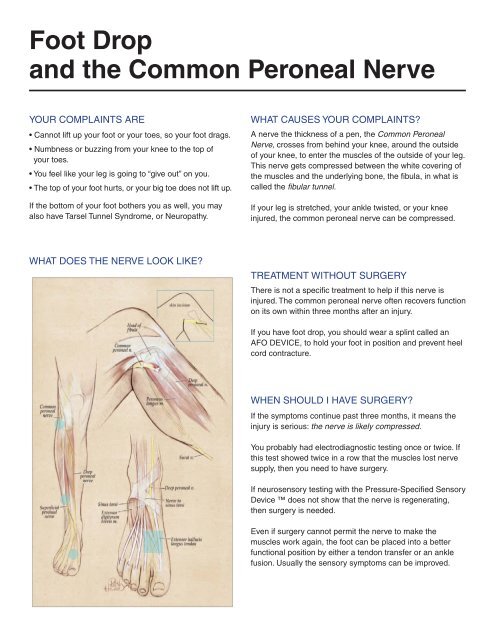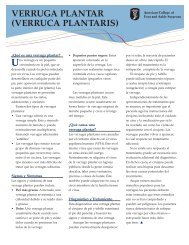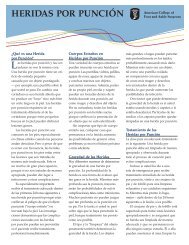Foot Drop and the Common Peroneal Nerve - Head To Toe ...
Foot Drop and the Common Peroneal Nerve - Head To Toe ...
Foot Drop and the Common Peroneal Nerve - Head To Toe ...
Create successful ePaper yourself
Turn your PDF publications into a flip-book with our unique Google optimized e-Paper software.
<strong>Foot</strong> <strong>Drop</strong><strong>and</strong> <strong>the</strong> <strong>Common</strong> <strong>Peroneal</strong> <strong>Nerve</strong>Your complaints are• Cannot lift up your foot or your toes, so your foot drags.• Numbness or buzzing from your knee to <strong>the</strong> top ofyour toes.• You feel like your leg is going to “give out” on you.• The top of your foot hurts, or your big toe does not lift up.If <strong>the</strong> bottom of your foot bo<strong>the</strong>rs you as well, you mayalso have Tarsel Tunnel Syndrome, or Neuropathy.what causes your complaints?A nerve <strong>the</strong> thickness of a pen, <strong>the</strong> <strong>Common</strong> <strong>Peroneal</strong><strong>Nerve</strong>, crosses from behind your knee, around <strong>the</strong> outsideof your knee, to enter <strong>the</strong> muscles of <strong>the</strong> outside of your leg.This nerve gets compressed between <strong>the</strong> white covering of<strong>the</strong> muscles <strong>and</strong> <strong>the</strong> underlying bone, <strong>the</strong> fibula, in what iscalled <strong>the</strong> fibular tunnel.If your leg is stretched, your ankle twisted, or your kneeinjured, <strong>the</strong> common peroneal nerve can be compressed.What does <strong>the</strong> nerve look like?treatment without surgeryThere is not a specific treatment to help if this nerve isinjured. The common peroneal nerve often recovers functionon its own within three months after an injury.If you have foot drop, you should wear a splint called anAFO DEVICE, to hold your foot in position <strong>and</strong> prevent heelcord contracture.when should i have surgery?If <strong>the</strong> symptoms continue past three months, it means <strong>the</strong>injury is serious: <strong>the</strong> nerve is likely compressed.You probably had electrodiagnostic testing once or twice. Ifthis test showed twice in a row that <strong>the</strong> muscles lost nervesupply, <strong>the</strong>n you need to have surgery.If neurosensory testing with <strong>the</strong> Pressure-Specified SensoryDevice does not show that <strong>the</strong> nerve is regenerating,<strong>the</strong>n surgery is needed.Even if surgery cannot permit <strong>the</strong> nerve to make <strong>the</strong>muscles work again, <strong>the</strong> foot can be placed into a betterfunctional position by ei<strong>the</strong>r a tendon transfer or an anklefusion. Usually <strong>the</strong> sensory symptoms can be improved.
what are <strong>the</strong> risks of surgery?The published outcomes of <strong>the</strong> Dellon-approach to <strong>the</strong>treatment of <strong>the</strong> common peroneal nerve compression offer<strong>the</strong> best chance of success for relief of your symptoms.There are risks associated with every surgical procedure,such as <strong>the</strong> risk of anes<strong>the</strong>sia, bleeding, <strong>and</strong> infection.Complications unique to decompression of <strong>the</strong> commonperoneal nerve are:• Temporary weakness of <strong>the</strong> muscles that lift <strong>the</strong> foot/toes.• Increased buzzing or tingling from <strong>the</strong> knee to <strong>the</strong> toes.• A painful scar due to entrapment of a small cutaneousnerve in <strong>the</strong> incision.• Ano<strong>the</strong>r site of entrapment, <strong>the</strong> lower leg (superficialperoneal), or top of <strong>the</strong> foot (deep peroneal) may require asecond surgery to decompress <strong>the</strong> nerve at that location,too.who should do this surgery?Tucson Neuropathy InstituteSpecializing in Pain Relief for <strong>the</strong> Legs & Feet7406 N. La Cholla Blvd.Tucson, Arizona 85741520-545-0202www.headtotoehealthcare.orgDr. Alan T. ShihFellow, American Association of LowerExtremity Peripheral <strong>Nerve</strong> SurgeonsSurgeons from <strong>the</strong> Dellon Institutes for Peripheral<strong>Nerve</strong> Surgery ® have <strong>the</strong> most advanced training <strong>and</strong>experience doing this surgery, which offers you <strong>the</strong> bestchance for success.being academic in private practice SMMackinnon, S.E., Dellon, A.L.: Surgery of <strong>the</strong> Peripheral <strong>Nerve</strong>, Chapter 12, pp.320-336, Thieme Pub., New York, N.Y., 1988.Dellon, A.L.: , Entrapment of <strong>the</strong> deep peroneal nerve on <strong>the</strong> dorsum of <strong>the</strong> foot. <strong>Foot</strong> <strong>and</strong> Ankle 11:73-80, 1990.Mont MA, Dellon, AL, Chen F, Hungerford MW, Krackow KA, Hungerford DH: Operative treatment of peroneal nerve palsy. J Bone JointSurgery 78A:863-869, 1996.Tassler PL, Dellon AL: Pressure perception in <strong>the</strong> normal lower extremity <strong>and</strong> in tarsel tunnel syndrome. Muscle <strong>Nerve</strong> 19:285-289,1996.Dellon, AL, Ebmer J, Swier P: Anatomic variations related to decompression of <strong>the</strong> common peroneal nerve at <strong>the</strong> fibular head. AnnPlast Surg, 48: 30-34, 2002.Rosson, GD, Dellon AL: Entrapment of <strong>the</strong> Superficial <strong>Peroneal</strong> <strong>Nerve</strong>, Clinical Orthop; Rel Res, 438: 248-252, 2005.Dellon, AL: Post-arthoplasty palsy <strong>and</strong> systemic neuropathy: A peripheral nerve management Algorithm, submitted Annals Plast Surg,55: 638-642, 2005.





